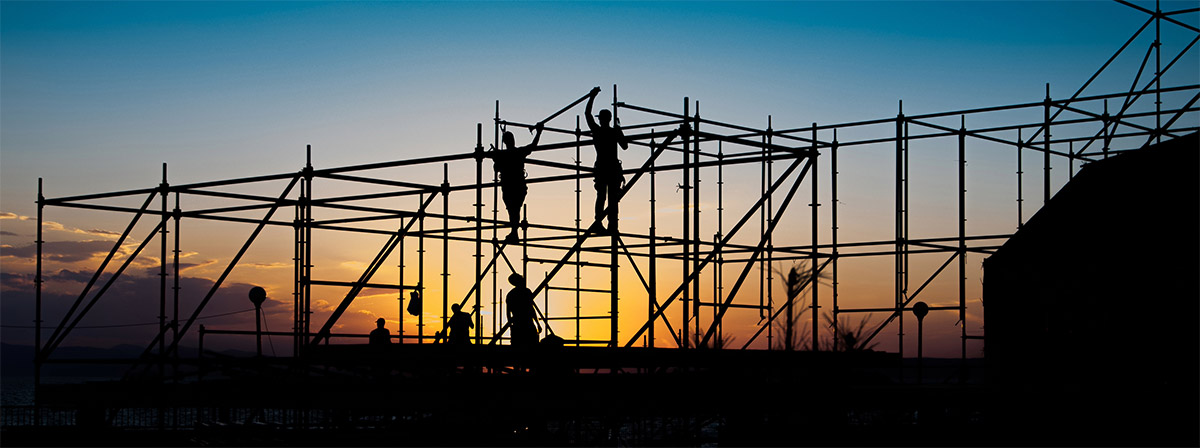Scaffolding Safety

What to Consider When Hiring a Professional
Scaffolding refers to the temporary structure erected to support workers and materials during the construction, repair, or maintenance of structures. Navigating heights and accessing hard-to-reach areas in construction can be daunting, and that's precisely why it's crucial to entrust the task of erecting scaffolding to the right professionals.
Installing scaffolding is not just about creating a platform; it's fundamental to ensuring safety at elevated work sites. Remember, the right people for the job make all the difference in creating a safe and efficient working environment.

Who should put up the scaffold?
In Australia, scaffolding work is considered high risk, and specific regulations and requirements are in place to ensure the safety of workers involved in the erection, alteration, and dismantling of scaffolding.
A High-Risk Work License is required for professionals involved in scaffolding work. The classes include Basic Scaffolding (SB), Intermediate Scaffolding (SI), and Advanced Scaffolding (SA).
To obtain an HRW license for scaffolding, individuals must undergo accredited training and assessment provided by registered training organizations (RTOs). This training covers the safe erection, alteration, and dismantling of scaffolding and relevant regulations.
Compliance with standards
The primary standard governing scaffolding in Australia is the AS/NZS 1576 scaffolding series. This standard applies to the assembly and dismantling of scaffolding and the design, manufacture, import, and supply of scaffolding equipment.
AS/NZS 1576 outlines comprehensive requirements for scaffolding and provides specifications and regulations for various types of scaffolding, including prefabricated scaffolding, prefabricated tube and coupler scaffolding, metal tube and coupler scaffolding, suspended scaffolds, couplers and accessories, prefabricated split heads and trestles, prefabricated vertical ladders, and prefabricated steel stair treads.
What makes a safe scaffolding?
A safe scaffolding structure is characterized by several key features and practices designed to ensure the well-being of workers and prevent accidents. Here are some elements that contribute to a safe scaffolding setup:
1. Solid Foundation
The scaffolding should be erected on a stable and level surface, supporting the structure's weight, workers, and equipment or materials.
2. Proper Assembly
The scaffolding components should be assembled according to the manufacturer's instructions and industry standards. All connections, joints, and couplings must be secure to prevent structural failure.
3. Guardrails and Toeboards
To prevent falls, guardrails and toeboards should be installed along all open sides of the scaffolding platforms. This is a critical safety measure, especially when working at heights.
4. Sturdy Platforms
The scaffolding platforms must be sturdy, well-constructed, and capable of supporting the intended loads. They should be free of defects, such as holes or weak spots.
5. Access Points
Safe access points like ladders or stairs should allow workers to ascend and descend the scaffolding safely. Climbing directly on the cross-braces or frames is generally not recommended.
Additional safety measures
In addition to the fundamental safety measures mentioned earlier, several additional safety practices and precautions are used in scaffolding work to enhance overall safety on construction sites.
1. Safety Netting
Installing safety netting below scaffolding platforms can provide additional protection in case of falls. Safety nets are designed to catch falling objects or workers, preventing them from hitting the ground.
2. Toeboards
Toeboards are barriers installed along the edge of scaffolding platforms to prevent tools, equipment, or materials from accidentally falling. They contribute to overall fall prevention.
3. Scaffold Stabilizers
Stabilizers, such as outriggers or bracing, enhance the stability of scaffolding, especially in freestanding or mobile scaffolds. This reduces the risk of tipping over.
4. Personal Fall Arrest Systems (PFAS)
Workers may use personal fall arrest systems, including harnesses and lanyards, to arrest a fall and prevent injury. These systems are particularly important when working at heights with a significant risk of falling.
5. Regular Inspections
Regularly inspecting scaffolding by competent persons helps identify and address potential hazards. This includes checking for loose and damaged components and ensuring the structure meets safety standards.
6. Emergency Procedures
Establishing clear and effective emergency procedures, including rescue plans, ensures workers know what to do in an accident or emergency. This includes having trained personnel for emergency response.
7. Weather Monitoring
Regular monitoring of weather conditions is crucial, especially in outdoor scaffolding work. Adverse weather, such as strong winds or heavy rain, can impact the stability and safety of the scaffolding structure.
Scaffolding involves inherent hazards, and combining various safety measures creates a layered defense system to protect workers and others in and around the worksite.
Scaffolding Suppliers
Many construction sites in Australia hire scaffolding, or engage a specialist scaffolding contractor. Some builders will purchase used scaffolding and erect themselves.
There are scaffolding brands -:
In summary
Beyond safety considerations, professional scaffolding workers bring efficiency and effectiveness to construction projects. Their experience in proper scaffolding assembly not only ensures the safety of workers but also enhances the project's overall productivity. With a thorough understanding of engineering principles and adherence to manufacturer guidelines, professionals contribute to stable scaffolding structures that withstand the demands of construction tasks.
SEARCH ARTICLES
Recent Posts
- Jul, 22, 2025
Who is responsible for that water leak?
- May, 6, 2025
Diversity on Boards
- Apr, 11, 2025
When does asbestos become dangerous in your home?
- Jan, 23, 2025
How Design Aesthetics Shape Perceived Value
- Dec, 10, 2024
Impact of Inflation on First-Time Buyers
- Nov, 4, 2024
How to understand and check your credit score
- Sep, 19, 2024
Buying off the plan? Beware of sunset clauses
- Jul, 5, 2024
Essential Workers Explained
- Jun, 13, 2024
Ozone Generators to remove Mould
- Feb, 19, 2024
Massive tax handouts for property investors
- Feb, 16, 2024
Body Corporate sinking fund - QLD
- Sep, 20, 2023
Learning to Negotiate
- Jul, 11, 2023
Pension Age Rises to 67
- May, 18, 2023
Becoming A Registered Builder In Australia
- Apr, 17, 2023
Forced Sales - Queensland - 75% Rule
- Dec, 6, 2022
Petty Landlords & Negative Gearing
- Sep, 19, 2022
The benefits of shade sails for your home
- Jul, 27, 2022
Termite Swarmers Season
- Jun, 22, 2022
Fear of missing out driving inflation
- Apr, 28, 2022
Australia's Rental Crisis
- Mar, 7, 2022
Should you buy a home with Termite damage?
- Mar, 3, 2022
Tactics to reduce body corporate disputes
- Jan, 25, 2022
Globalisation - The Hedgehog & The Fox
- Nov, 2, 2021
Revealed: Top 10 areas to avoid buying
- Oct, 28, 2021
Is that house protected against termites?
- Sep, 15, 2021
Tree Changers & Sea Changers
- Aug, 12, 2021
COVID 19 and Body Corporate Responsibilities
- Jul, 29, 2021
Tenants beware of rental rewards schemes
- Jun, 25, 2021
Sunshine Coast versus Gold Coast
- Jun, 23, 2021
Your superannuation and your home
- Jun, 11, 2021
How many properties sit empty?
- May, 10, 2021
What Returns could I make from Property Investment
- May, 4, 2021
Real Estate Agents and Property Managers
- Apr, 20, 2021
Why You Need A Termite Inspection
- Mar, 19, 2021
SEO for Real Estate websites
- Mar, 18, 2021
Three Reasons Why Your Home Needs Data Cabling
- Mar, 16, 2021
Smoke Alarms: What you need To know in QLD
- Dec, 10, 2020
Pre-purchase Electrical Inspection
- Dec, 4, 2020
Why should I drink Adelaide Hills Wines?
- Aug, 26, 2020
Amalgamation of Strata-titled Lots for Development
- Jul, 28, 2020
Adelaide Hills a unique region
- Apr, 28, 2020
Ozone Generator in Your Home
- Apr, 21, 2020
Air conditioning cleaning
- Apr, 14, 2020
Housing Affordability in Australia
- Apr, 6, 2020
Security Systems
- Mar, 31, 2020
Termites and protecting the home
- Feb, 27, 2020
Printing for the Real Estate Industry
- Nov, 12, 2019
Beware of Property Investment Spruikers
- Oct, 31, 2019
Prices for Home Alarm Monitoring
- Oct, 9, 2019
House and Land packages best investment
- Oct, 1, 2019
The 'Scourge' of Underquoting
- Oct, 16, 2017
Professional Pest Control
- Sep, 29, 2017
Built in Wardrobes
- Jul, 9, 2015
Pool Inspections Queensland
- Jun, 25, 2015
Negotiating your purchase with the Inspection
- May, 12, 2015
DIY Move or hire a removalist company?
- Nov, 19, 2014
Why are housing prices rising faster than wages?
- Jan, 17, 2014
The Friendliest Real Estate Agents
- Jul, 23, 2013
A thorough Building and Pest Inspection
- Sep, 28, 2012
How to Compare Home Loans
- Jan, 25, 2012
Southport Real Estate

